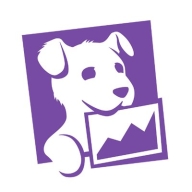

Datadog and DNIF HYPERCLOUD compete fiercely in the observability and infrastructure monitoring sphere. Datadog seems to have the upper hand due to its wide array of hosted features and seamless integrations, enhancing user experience and monitoring capabilities.
Features: Datadog offers a robust set of hosted features such as sharable dashboards and intuitive tagging, alongside seamless integrations with AWS, Docker, and Splunk. Its comprehensive monitoring tools assist in root cause analysis and metric visualizations efficiently. In contrast, DNIF HYPERCLOUD provides significant infrastructure flexibility, allowing integration with various open-source and data sources, but may lag in ready-made integrations compared to Datadog.
Room for Improvement: Datadog could improve API consistency, offer better pricing transparency, enhance database-monitoring features, expand front-end application support, and boost logging capabilities. DNIF HYPERCLOUD stands to benefit from broadening integration capabilities, reducing infrastructure demands, and simplifying its command-line processes.
Ease of Deployment and Customer Service: Datadog is primarily deployed across public, private, and hybrid cloud environments, with customer service being proactive yet inconsistent in response speed. Technical support quality varies, with some satisfaction and others reporting delays. DNIF HYPERCLOUD, often deployed on-premises and in hybrid settings, receives praise for immediate customer service and consistent support but needs speed and availability improvements.
Pricing and ROI: Datadog's flexible pricing model can unexpectedly lead to high costs, posing a challenge for smaller organizations. Despite this, it provides significant ROI by saving time in bug assessment and reducing downtimes. Conversely, DNIF HYPERCLOUD offers competitive pricing appealing to budget-limited clients, though its infrastructure demands can be costly. It provides good ROI via performance monitoring and analytics, making it an economical choice.
| Product | Market Share (%) |
|---|---|
| Datadog | 5.7% |
| DNIF HYPERCLOUD | 0.3% |
| Other | 94.0% |


| Company Size | Count |
|---|---|
| Small Business | 78 |
| Midsize Enterprise | 42 |
| Large Enterprise | 82 |
| Company Size | Count |
|---|---|
| Small Business | 3 |
| Midsize Enterprise | 1 |
| Large Enterprise | 3 |
Datadog integrates extensive monitoring solutions with features like customizable dashboards and real-time alerting, supporting efficient system management. Its seamless integration capabilities with tools like AWS and Slack make it a critical part of cloud infrastructure monitoring.
Datadog offers centralized logging and monitoring, making troubleshooting fast and efficient. It facilitates performance tracking in cloud environments such as AWS and Azure, utilizing tools like EC2 and APM for service management. Custom metrics and alerts improve the ability to respond to issues swiftly, while real-time tools enhance system responsiveness. However, users express the need for improved query performance, a more intuitive UI, and increased integration capabilities. Concerns about the pricing model's complexity have led to calls for greater transparency and control, and additional advanced customization options are sought. Datadog's implementation requires attention to these aspects, with enhanced documentation and onboarding recommended to reduce the learning curve.
What are Datadog's Key Features?In industries like finance and technology, Datadog is implemented for its monitoring capabilities across cloud architectures. Its ability to aggregate logs and provide a unified view enhances reliability in environments demanding high performance. By leveraging real-time insights and integration with platforms like AWS and Azure, organizations in these sectors efficiently manage their cloud infrastructures, ensuring optimal performance and proactive issue resolution.
DNIF HYPERCLOUD is a cloud native platform that brings the functionality of SIEM, UEBA and SOAR into a single continuous workflow to solve cybersecurity challenges at scale. DNIF HYPERCLOUD is the flagship SaaS platform from NETMONASTERY that delivers key detection functionality using big data analytics and machine learning. NETMONASTERY aims to deliver a platform that helps customers in ingesting machine data and automatically identify anomalies in these data streams using machine learning and outlier detection algorithms. The objective is to make it easy for untrained engineers and analysts to use the platform and extract benefit reliably and efficiently.
We monitor all Log Management reviews to prevent fraudulent reviews and keep review quality high. We do not post reviews by company employees or direct competitors. We validate each review for authenticity via cross-reference with LinkedIn, and personal follow-up with the reviewer when necessary.